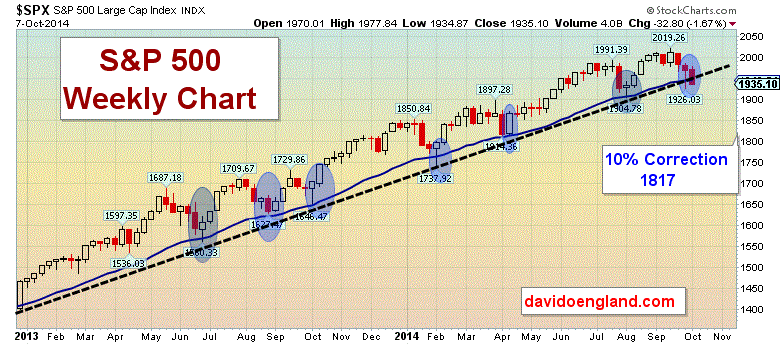Today I answer: “Using your technical analysis tools, what will you be watching to see if we are headed for a correction?” Before I answer, keep in mind a correction is a 10 percent pullback from a previous high. If 2,019 is a market top, then a 10 percent correction would take the S&P 500 to the 1,817 level. Many fear corrections; I welcome them--they can lead to many profitable trading and investing opportunities.
Per my chart, I feature a weekly chart of the S&P 500 using Japanese candlesticks. Since the beginning of 2013, the S&P 500 has successfully bounced off my blue signal line and longer term (black slotted) trendline. The last candle only represents the action until Tuesday -- the day this column is composed. By the end of the week, the price may or may not have retraced above the lines.

To signal an upcoming correction, turn off the hype from the national media and watch two simple items: my blue signal line and longer-term trend line. Remember the saying “The trend is your friend?” It works in this situation also. When or if the price breaks down through my blue signal line and the black-slotted rend line and fails to rally back above them, this represents more selling than buying and can signal lower prices ahead.
The tough part -- you do not know what price level will stimulate the next round of buying. Many have no business shorting the market--making money when the market goes down. When shorting, your losses can be unlimited. Yes, you could actually lose more money than you have in your account. When going long, the most you can lose is the full price of your security.
Why do I like market pullbacks? I focus on investing in closed-end and exchange-traded funds that pay at least 6 percent more in dividends than total expenses and have the dividends reinvested in more shares. When the prices dip, the dividends buy more shares-it is that simple. Wall Street focuses on price appreciation. I like to focus on share growth, a strategy I call “Growing Gardens.” What other strategy do you know where investors are smiling when the market is heading south?
I have taught many students these simple systems--you can learn as well. From a personal standpoint, learn the benefits of share growth using high-paying funds and dividend reinvestment. In the years ahead, you may be glad you did!
Plan your work, work your plan and learn to share your harvest
David England
